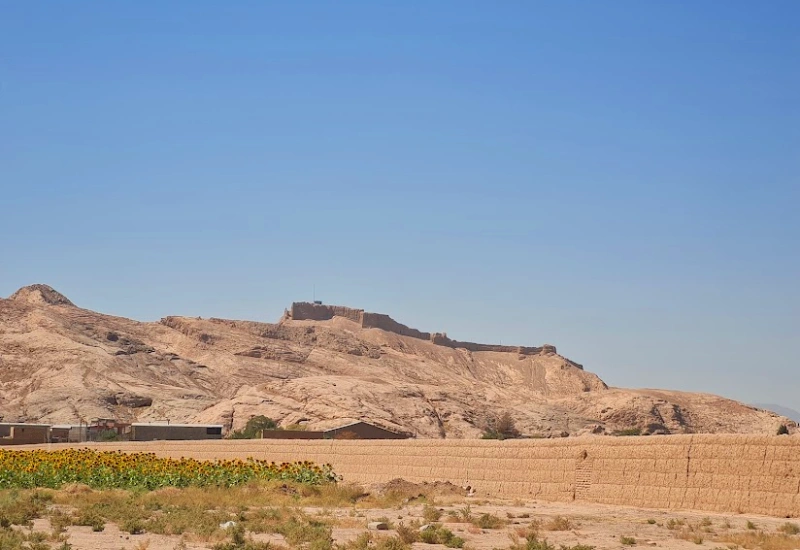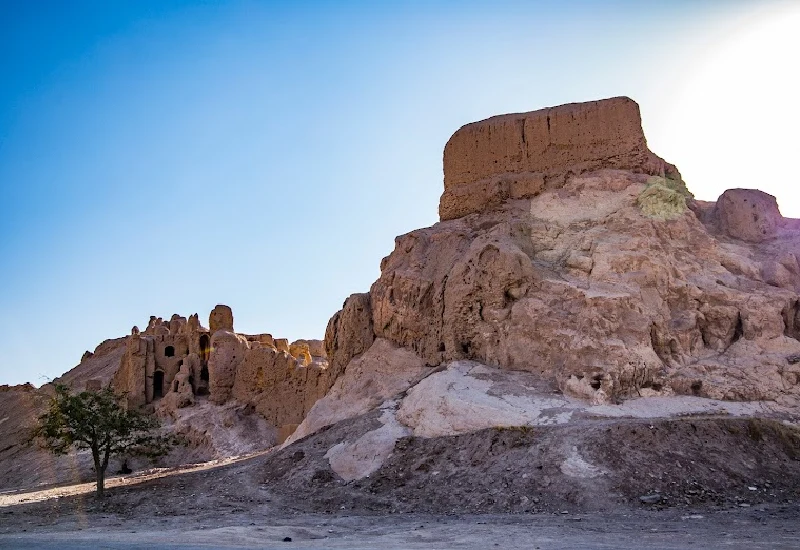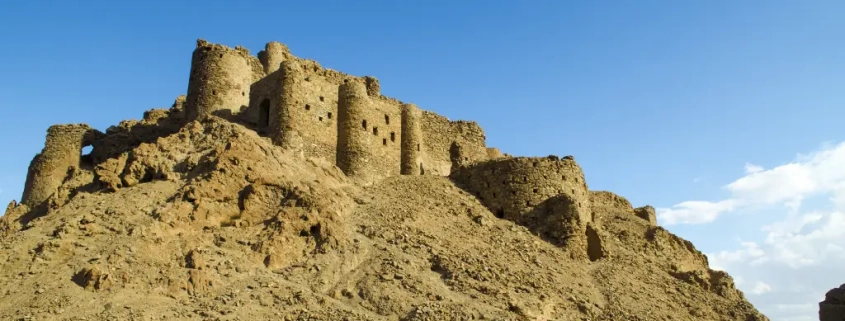Qaleh Dokhtar Kerman (Facts, Photos, Location)
The abundance of historical and ancient places in Kerman province has positioned it as the fifth most important historical province of Iran. This province displays a total of more than 700 historical works, only a part of which has been registered in the list of national heritage of Iran. Historical and ancient sites, especially castles, form an important part of the cultural heritage of Kerman and can be found in the historical cities of this province. One of the ancient castles of this region is Qaleh Dokhtar (Dokhtar Castle) of Kerman, which is known as one of the oldest ancient castles in Iran and is one of the top things to do in Kerman. Let’s learn more about this castle.
About Qaleh Dokhtar
Qaleh Dokhtar, this ancient building, is a historical and ancient fort in Iran, which is located near the Ardashir Castle in Kerman and is known by famous names such as Qaleh Kuh (Mountain Castle) or Anahita Fire Temple. The history of this fort goes back to ancient times and it is said that it was created more than 3000 years ago.
History of Qaleh Dokhtar in Kerman
The initial core of Kerman city includes an area known as Qaleh Dokhtar (Dokhtar Castle) or the Anahita Fire Temple, along with the nearby Ardashir Castle, both dating back to the Sassanian era.
According to some archaeologists and historians, Qaleh Dokhtar was known as a place of fire worship, which led to its alternative name, the Anahita Fire Temple. Revered as the goddess of water, fertility, plants, and women, Anahita held an important place in ancient culture and attracted the respect and devotion of many people of that time. In the eyes of past societies, worshiping this goddess was considered essential and very valuable.

Kerman Dokhtar Castle is structurally divided into two main parts: one part is located on top of the mountain known as Qaleh Kuh (Mountain Castle) and the other parts are located on a lower and less elevated ground. Historical sources, including some ancient texts, relate this building to the Sassanid period. Both Ardashir Castle and Qaleh Dokhtar are prominent attractions in Kerman that attract many visitors from all over the world every year.
Unfortunately, this fort, like many other ancient and historical places, has made the least effort to preserve and protect it, and the illegal structures around it and the installation of telecommunication towers inside the historical area have caused its gradual destruction, risking the loss of this fort’s historical and cultural significance.
Qaleh Dokhtar Naming
The name of Qaleh Dokhtar (Dokhtar Castle) in Kerman is a metaphor in the Persian language that symbolizes “untouched”, “pure” and “unconquerable”. Historically, Iranians often chose the word Dokhtar (meaning girl) for their castles, which were built mainly for protection and defense.
More specifically, this naming convention highlights the castle as a place with pristine, invincible, and impenetrable qualities. Other examples of Iran’s historical castles with this name include Qaleh Dokhtar in Firuzabad, Fars, and Mianeh Qaleh Dokhtar in East Azerbaijan.
Qaleh Dokhtar Park in Kerman
To the green space of Kerman and provide a suitable environment for visiting this historical castle, a park has been built near the Qaleh Dokhtar site.
This park, which is known as “Qaleh Dokhtar Park of Kerman”, provides amenities such as prayer rooms and restrooms for local residents and tourists to enjoy its facilities and spend happy moments in this attractive green space.
Towers, Fortifications, and Defenses of Qaleh Dokhtar
The towers and fortifications of Qaleh Dokhtar form a complete circle with an opening of more than three kilometers. In most places, the cliff walls take on a cylindrical surface.
The only accessible route to the top of the cliff is a narrow passage on the shadowed north side of the cliff, which appears to be the only route to the castle. Hence, the rock slopes are fortified with walls and vast towers to guard the entrance to the pass.The entrance walls of the castle are about half a kilometer long and the stone base of these walls is more than two meters thick.

The wall is made of stone up to a height of two meters, on top of which a thick structure is made of clay and mud.This part of the fort has arches around it that resemble window openings that cannot be closed, allowing views in all directions. Inside this large area there are the remains of several small adobe buildings.
The site has a gate that opens to the north, and the ruins of the guard towers are still visible, marking the exact location of the gate. The slope of the area between the main ramparts and the entrance is quite steep, which leads to the entrance of the pass after a short distance.
Water Reservoirs of Qaleh Dokhtar in Kerman
Many reservoirs have been built in this castle, the capacity of some of them is hundreds of liters. By climbing the earthen elevation on the right side of the wall, you enter the fort after a few moments. This area includes more than ten reservoirs and water storage tanks.
On the shaded northern side of the fort, there are more cisterns than on the southern side. In the south, there are more than four reservoirs, one of which is particularly remarkable. This reservoir, which hangs from the rock, is more than 30 meters deep and more than 25 meters wide. Apparently, these reservoirs were filled with rainwater.
Residential Structures of Qaleh Dokhtar
The cliff can be divided into two parts: the southern and northern shaded areas. The southern shaded area is narrower than the northern one, consisting of two parallel valleys. These valleys, one of which is bigger than the other, contain the remains of interesting buildings.
On top of the ridge that separates the two valleys, there are remains of several architectural complexes.In this castle, which covers several hundreds of hectares, there are dozens of building complexes, some of which have thousands of square meters under the building.
Qal’eh Dokhtar Photos help to better understand its structure and arrangement.These architectural complexes consist of corridors with fine and narrow stone columns that show the taste and skill of the builder and the inhabitants of the castle.
Qaleh Dokhtar Facts
A famous legend about this fort is widely circulated in local gatherings and recognized by many historians and archaeologists.

According to this story, a powerful young woman took command of the castle and by using a special spell, she was able to protect it against the threats and attacks of the enemy and keep it safe from any challenge.
Qaleh Dokhtar in Kerman Location
There are two ancient castles around the city of Kerman, both of which are known as “Qaleh Dokhtar”. One of these castles is made of mud and is located in the heights between Zarisf and Mosalla Sahib al-Zaman mountain.
Another fort made of stone is located in the north of Kerman on the left side of the road leading to Zarand and about 10 kilometers from the city’s ring road.
This castle is located on a high cliff in the northern plains of Kerman, whose height reaches 400 meters. The area of the castle roof is more than 20 hectares and offers a wide view of the landscape.
Final Word
Qaleh Dokhtar in Kerman is a remarkable example of ancient Iranian architecture and culture. This historical place with its impressive fortifications, complex water reservoirs and attractive residential structures shows the ingenuity and creativity of its builders. The legends and rich history surrounding this fort continue to fascinate visitors and make it an important landmark in Iran’s cultural heritage.
Exploring Qaleh Dokhtar provides a unique glimpse into the past and highlights the importance of preserving such treasures for future generations.
Are you planning to travel to Iran and looking for an Iran resort? Consider Matinabad Eco-resort.





Leave a Reply
Want to join the discussion?Feel free to contribute!